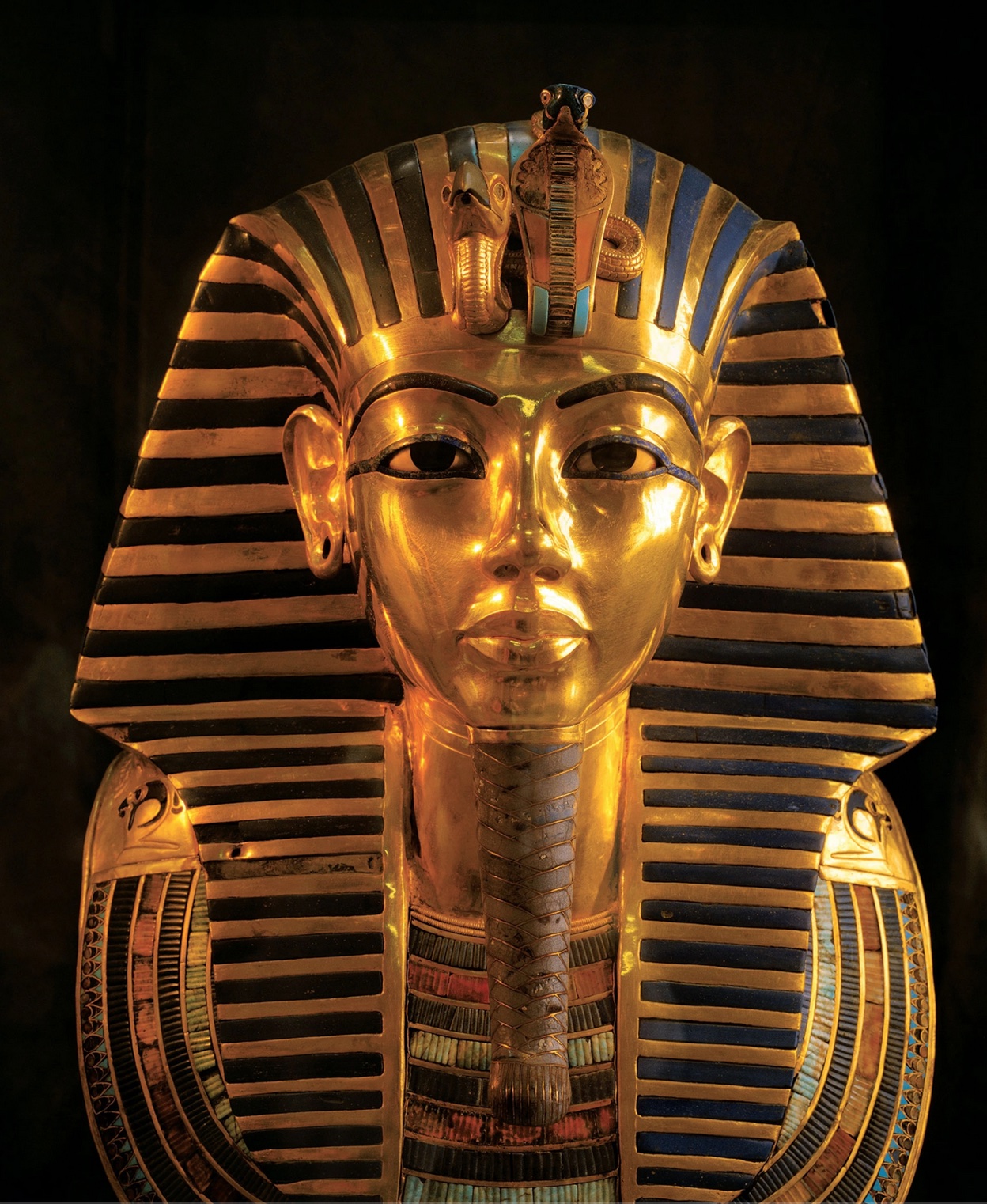Welcome to a new issue of the Journal of Runic Studies, the premier Malkioni publication for studies into the nature of Glorantha. If you haven’t subscribed yet, please consult with the spirit bound to the appropriate electronic page.
God Learner Sorcery
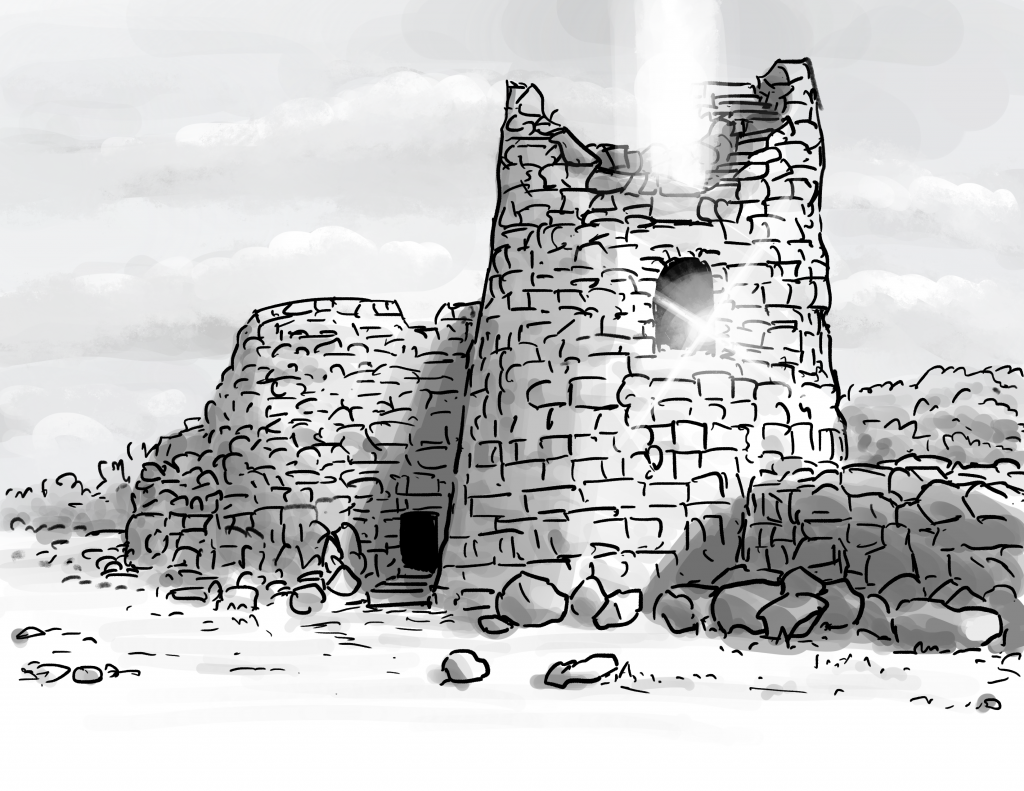
Here is what us God Learners were up to this week.
Episode 17: People of Glorantha: The Hsunchen
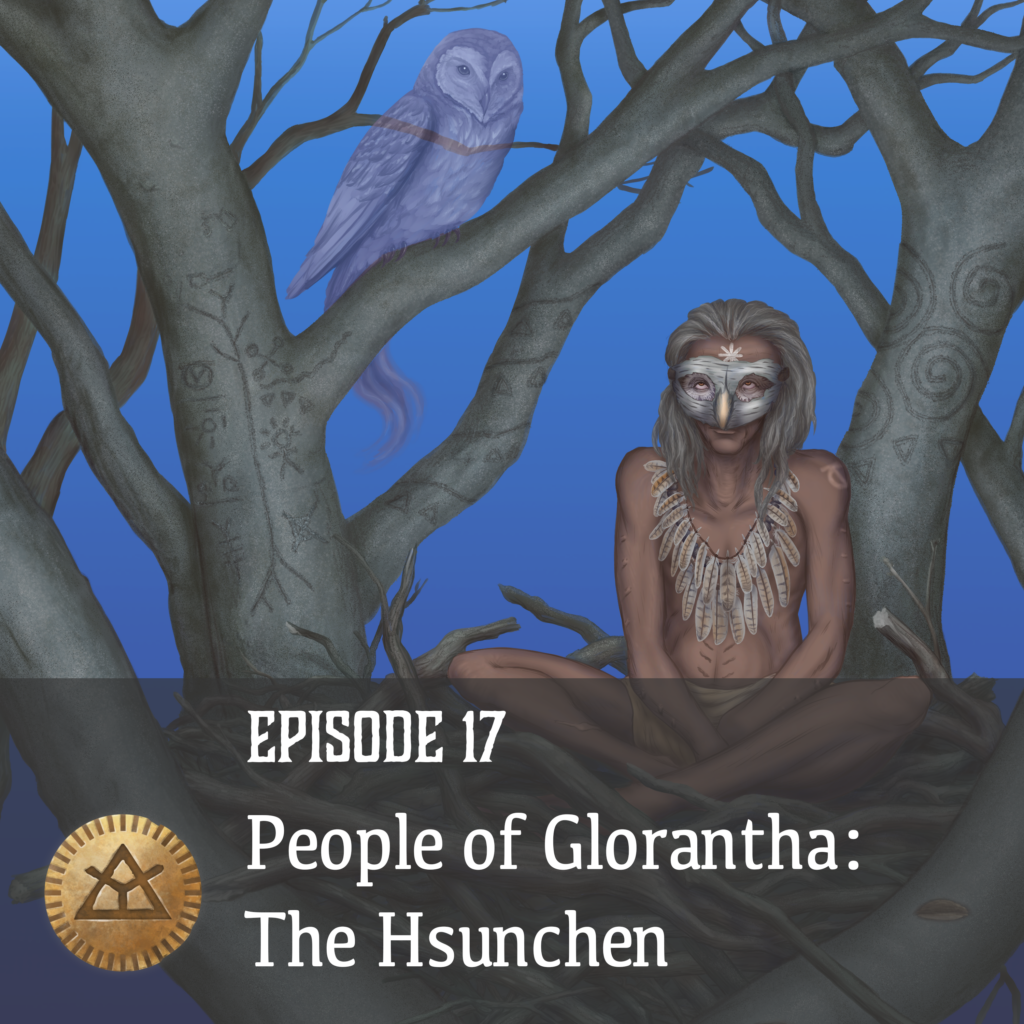
Episode 17 of the podcast is out, and I can now write “Hsunchen” properly the first time! This is thanks to Brian Duguid, author of the Children of Hykim and all-around expert on the Hsunchen. We chat about these stone age people of Glorantha, their totem animals, their culture and magic, and how to include them in your games.
Runic Rants: POW Gain House Rules
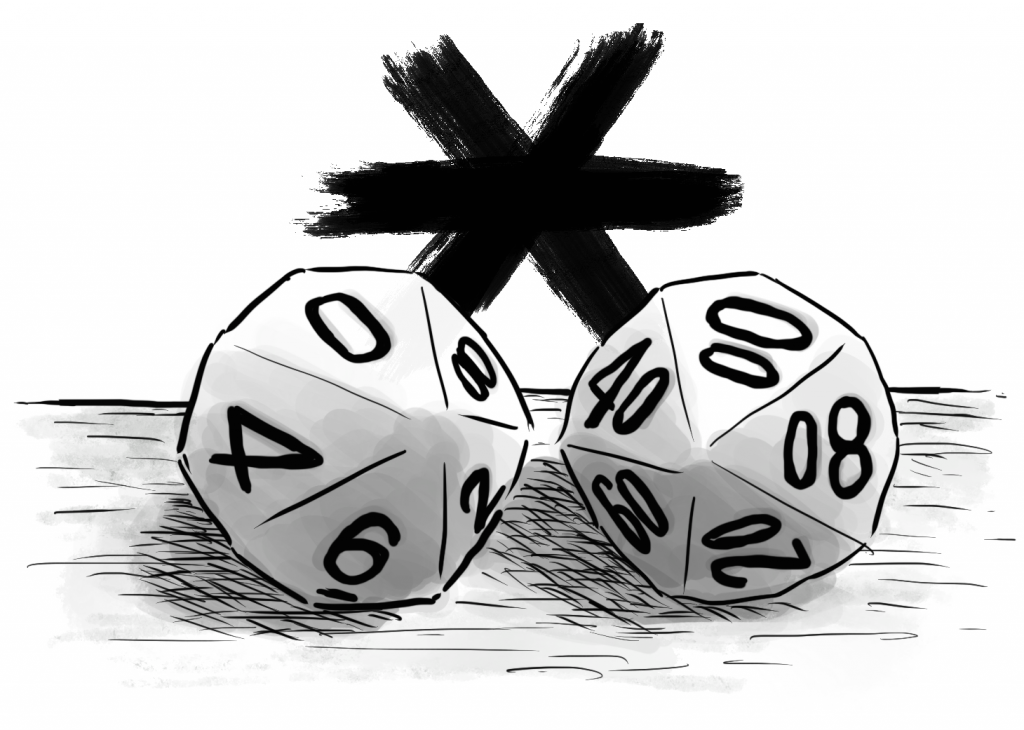
Here is a guest article by Austin Conrad, author of the Monster of the Month series (among many other things) and editor on both my adventures (A Short Detour and Bog Struggles). Austin shares his current POW Gain house rules for RuneQuest!
Chaosium News

Here are this week’s Chaosium news!
A New Hero Episode 06: Marsh of the Undead
As previously advertised, Chaosium’s “New Hero” actual play for RuneQuest is back! This makes me happy because I like the whole crew here, but most notably I really like James’ GMing. Anyway, the Varmandi siblings try to figure out what raised the dead near their home in the last adventure… and by doing so have to go near the dreaded Upland Marsh. But it’s not all doom and gloom: they fight a big thing that delights Bridgett and David!
I have caught up to episode 6, but episode 7 is also already out!
Jonstown Compendium

The Jonstown Compendium is Chaosium’s community content program for all Gloranthan games, hosted on DriveThruRPG. Disclaimer: all the relevant links are affiliate links that hopefully will let us cover some of the hosting and maintenance costs for the website and podcast! Thanks for using them!
Children of Hykim POD Preview
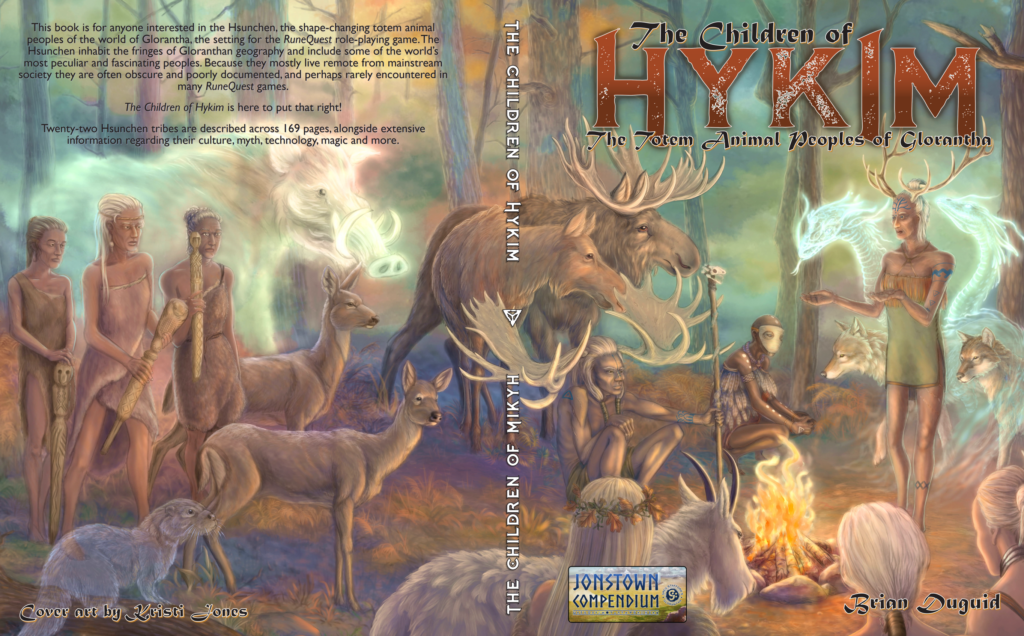
If you’ve been listening to our latest episode, you should already be buying Children of Hykim on the Jonstown Compendium… but if you need more motivation, look at this super gorgeous new cover by Kristy Jones that Brian is going to use for the upcoming Print-on-Demand version of the book!
The Crimson King is Coming
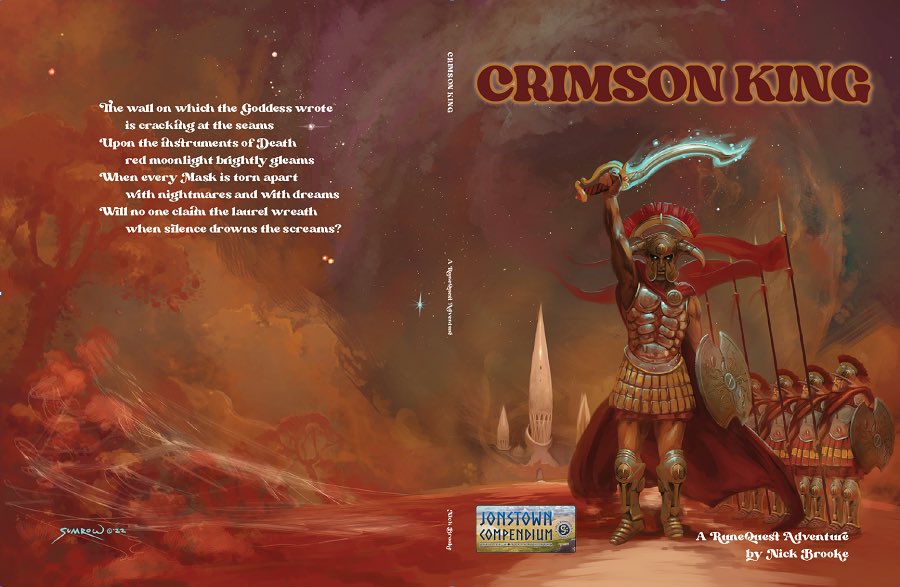
Nick Brooke has a preview of the absolutely amazing cover for his next RuneQuest adventure, The Crimon King. The art is by John Sumrow.
Jeff’s Notes

Jeff Richard, the current mastermind on everything Gloranthan at Chaosium, is often posting notes and thoughts on the RuneQuest Facebook group. Here’s our curated list from the past week. A partial archive of these sources is compiled on the Well of Daliath.
The Size of Genertela
Jeff talks about the size of Genertela, which is roughly similar to the continental United States.
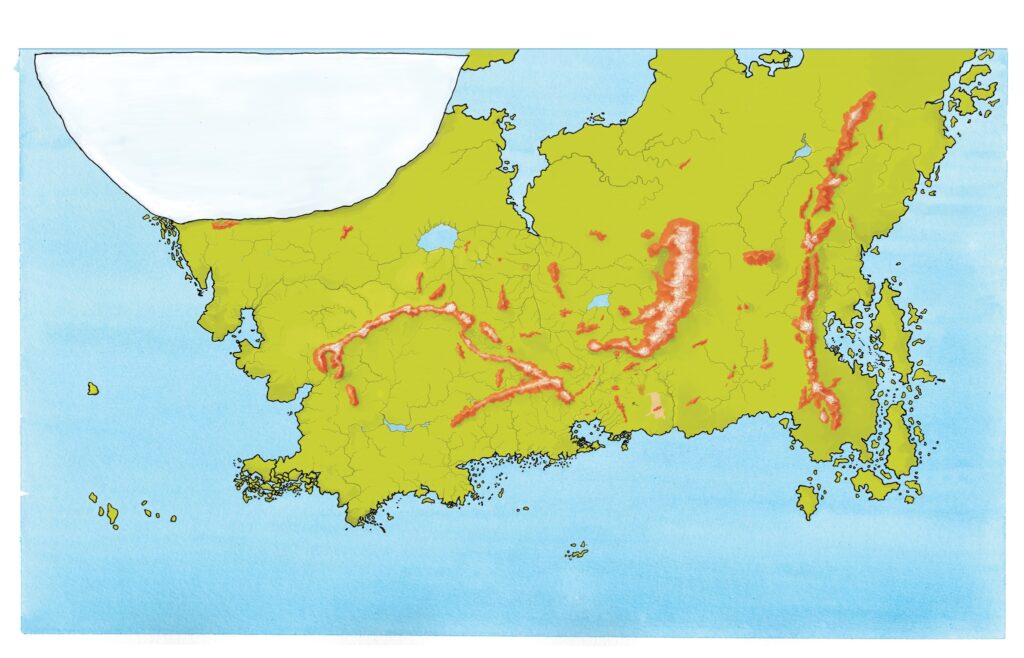
When I first got into Glorantha, I found it surprisingly small. Some of it has to do with the tropes I somehow grabbed upon. For instance, the Lunar Empire as a sort of fantasy Roman Empire. But when it comes to geography, that’s totally not the case:
Dragon Pass covers about 67,000 square kilometers. That’s a little smaller than Austria. Or a little bigger than West Virginia.
So if you think about the Lunar Empire, it covers about 390,000 square km, or about 5% of Genertela. That still is enough to make it the largest empire in Genertela.
But even so, the Lunar Empire is comparable to the size of modern Germany (it is a bit bigger). It is not the Roman Empire (which would cover 75% of Genertela).
The other reason I found Glorantha surprisingly small is that you can find dramatic changes in cultures and biomes across very short distances. Prax, its chaparral desert, and its nomads are right next to Sartar with its proto-Celt or proto-Greek (pick your publishing era) Orlanthi. And not too far from there are the sunny rice-paddies of the Lunar Provinces. This all looked very weird to me at first.
Of course, I later realized that this is sort of explained thanks to the massive influence of magic and gods over local climate and crops, for instance. So yeah, there’s a desert in Prax where there probably shouldn’t be a desert because some gods died a long time ago. And it’s a lot sunnier than it should be near the Dara Happan lands because that’s where the sun god’s strength is.
But… you know… still.
One of the things I really like about the scale of Genertela is means that every part of the continent has some contact with the rest of the continent. Let’s give a real world example – Pre-Columbian North America had extensive trade with Mesoamerica, and we know that the Mississippi River Valley facilitated trade between Wisconsin and the Gulf of Mexico. The Iroquois of the 18th century were known to travels from the St. Lawrence Seaway to the Carolinas to wage war on the “Flatheads” (aka the Cherokee, Choctaw, Chickasaw, etc.), as far as 1000 km away. In Glorantha that’s roughly about the distance from Glamour to Boldhome.
We know that Kralorelans sometimes travel to Dragon Pass and vice versa. Balazarings sometimes make their way to Prax. Merchants from the Holy Country can be found in almost every corner of the continent. People from the Lunar Heartlands make their way to Fronela and Ralios. And so on. The various cultures in Genertela are not hermetically sealed.
Tell that to the people under the Syndic’s Ban… but yes, sure. A smaller world means it’s easier to go murder-hobo’ing around it like Harrek and Argrath. Which is all the more ironic that 40 years of RuneQuest gaming have been focused on New Pavis and Sartar…
The White Bull Society

Speaking of Prax, here’s a note on the White Bull cult that expands into a lot of good contextual information on Prax vs the Wastes, the Lunar occupation, and more. I don’t have anything to add so just read the thing.
Can the God Time Change?
A thread on BRP Central asks whether the God Time can be changed, such as changing the nature of a god or changing the course of well known events. Jeff answers:
The archetypes and patterns of the God Time are eternal and fixed. But what we in Time experience of the God Time, what we call things, what we offer magic points to and draw upon when we use magic – that changes as we mortals do. “Myths” are the stories we tell about the God Time – we can see the God Time in our rites, our ceremonies, and when the Gods World is close to us. Sometimes we can even interact ourself with the archetypes and patterns of the God Time – that’s what we call Heroquesting.
The way I see it is something a bit like the story of the blind men and the elephant. You probably all know that story but, for the sake of God Learner inclusiveness, the gist of this Hindu parable is as follows: a bunch of blind men, who have no idea what the hell an elephant is, are trying to assess what a… well, what an elephant is. So they touch various parts of it and come up with different conclusions. One touches the trunk and says it’s like a snake. One touches the ear and says it’s like a fan. One touches it leg and says it’s like a tree. You get the idea.

So that’s how I figure the God Time works. It’s a big ass elephant, and people get a more or less incomplete picture from traditional stories passed down to them, and from heroquesting. If the elephant stomped on a monster that attacked your ancestors in the Great Darkness, maybe you have a story of a big sacred tree trampling your enemies. And maybe another tribe a few valleys from you has a story of the elephant blowing water into a well to give their ancestors something to drink, and now they have a sacred snake that can fix droughts, or something.
These stories are the myths, but they’re only one facet of what really goes on in the God Time. So when you enter the God Time through the rituals of your tribe, you indeed see some big-ass tree stomping poor little monsters… but maybe you can push further. Maybe you can climb the tree, or shine some bright light towards it, and you’ll see that its canopy also looks like bark — something that either escaped your predecessors, or something that was hidden from them because they saw what they wanted to see. Next thing you know, you’re climbing up something totally unknown, and maybe you slide down its trunk and end up in your tribal neighbour’s heroquests, and they go “hey what the fuck, how are you coming from the other end of that snake? we could never find that other end!” (and that’s why they called it “The One-Ended Snake”).
At this point you can completely change the myth (it’s not a story about a snake and a tree, it’s a story about an elephant), while not changing what happened in the God Time — there’s still something thing that brought water to some people, and crushed other people’s enemies. This can bring some opportunities of friendship between the two aforementioned tribes, and so on. The trickiest parts in all this are (1) proving your discoveries to the tribal elders and (2) coming up with a name for the elephant.
Of course, since the BRP Central thread had predictably gone in the “Yelmalio Problem”, Jeff address that next…
Yelmalio – Little Sun – is a title. We apply it to the Light in the Darkness, the light remained when the Sun was killed and the light that refused to go out in the Darkness. We have places where we can meeting the Little Sun, where he is so close you can reach out to touch him. We can walk in his path and ascend to the Hill of Gold and try to fight against the Darkness, but we know that our god was defeated by Orlanth and robbed by Zorak Zoran – that’s part of his definition. If we do not experience that, we do not follow in his path. Like a Jesus who is not crucified.
For those of you new around here, the “Yelmalio Problem” has to do with the many people who talk about “fixing” Yelmalio’s main myth, in which he gets (among other things) attacked by the troll berserker god Zorak Zoran and gets his fire powers stolen (which is why Yelmalio cultists don’t get any fire magic)… as if you were to “fix Superman” by preventing Krypton from blowing up or, as Jeff puts it, “fix Jesus” by avoiding the crucifixion.
Frankly, apart from a few minmaxers, I think (for what it’s worth) that most people are not actually looking to change Yelmalio’s myths. Rather, Yelmalio’s myth is an easy one to grab when you want to try and wrap you head around what the fuck is heroquesting and how the fuck does it work. With its heroquest that contains something you’re supposed to fail, and consequences that affect other myths and cults (Zorak Zoran’s story, in this case, and his cultists’ access to fire magic), it’s got quite a few properties that make it practical for thought experimentation — which is an inevitable step of any newbie Gloranthaphile until we have an actual heroquesting sourcebook that explains all this shit.
But perhaps something we thought was the Little Sun – his Golden Spear perhaps – is something that we can draw power from directly. We can worship the Golden Spear as a god, separate (but associated) with Yelmalio. Or perhaps we see the time that Yelmalio worked with Orlanth and decide to focus only upon that, and call that subset of Yelmalio with the name Elmal. Or perhaps we experience Yelmalio as merely the light that emanates from Yelm, and worship Yelmalio merely as an attribute of Yelm.
Perhaps on a heroquest, we follow Yelmalio’s path, are extinguished but rekindle ourself with our purity. We bring this back to our temple with a new Rune Spell of one-use Resurrection or maybe just Restart Fire. Perhaps we gain a new gift, not on the list, or take a new geas, not previously seen. In this way, cults may change.
So Yelmalio’s story, his myth, is just one story we tell about the “immutable pattern” of the “Light The Didn’t Go Out In The Darkness”. There could be a completely different story about this… the question is whether this different story covers as many bases as the Yelmalio story, which has been “researched” (heroquesting-wise) for generations. That story needs to cover the same bases as Yelmalio’s in terms of correctly representing all the facets of the original patterns, such as its connection (whatever it is) to the Sun, and so on. Chances are that if you make up an alternate story, it might not model the original pattern as well, and as such you might not draw as powerful magic as through the Yelmalio myth… or maybe you will! Go crazy with your games, I’m not your mom!
As for the Red Goddess, Jeff adds:
Now the Red Goddess was different. She is something that did not exist in the God Time. Our Red Goddess went deep into the Underworld, was defeated and lost, met the Cosmic Spider and was illuminated by Nysalor, and bound the Devil in order to change the cosmos. In short, she used Chaos to break the Cosmic Compromise and create a new archetype that had not existed in the God Time – the Red Moon. Sure there was a broken and dead Moon Goddess, several even. But they were broken pieces of a funhouse mirror. But the Red Goddess reassembled those fragments and used Chaos to do the impossible.
The only other example that comes close is the use of the Pseudo-Cosmic egg by the Second Council to create a new god – Osentalka the Perfect One.
This all reminds me a bit of Unknown Armies and its Invisible Clergy, made up of 333 “Archetypes” of humanity and reality (The Mother, The Warrior, The True King, The Usurper, etc.) Their Avatars and Godwalkers try to emulate these archetypes as best as possible to channel their most potent magic and, eventually, ascend themselves and replace the previous Archetype. In at least one scenario, someone taps into the zeitgest of the 21st century and attempts to create a new Archetype that didn’t exist before. Does that all sound familiar?
There are a few other games that also follow along similar lines, but Unknown Armies is the one that I like best, and also the one in which this whole idea is best described and executed as far as I’m concerned… at least if you’re into urban horror.
Note that Jeff posted most of this note on Facebook, and as such it’s been archived on the Well of Daliath.
Community Roundup
The community roundup is our highlight of interesting things being mentioned in the Glorantha-related Facebook groups, sub-Reddits, and other similar online places.
Calling the Praxian Founders

The RuneQuest “Call Founder” spell gets some good coverage on this BRP Central thread. Of course, Praxian expert David Scott (who guided us through the Nomad Gods rulebook on the podcast, here and here) shared the most awesome bit, which is a table of possible stats for those founders. With STR and POW in the hundreds, this isn’t your usual cult spirits!
Anyway, David’s table made me go “huh” because I hadn’t really thought of associating each Praxian tribe with a different Rune, like he did here: Bison/Air, High Llama/Water, Morokanth/Darkness, Sable/Moon, and so on. I’m not sure where the rest of the independent tribes goes in this model, but… well… “huh”.
Science and the Lunar Way
Eff is back to writing pseudo-Socratic dialogues for more obscure Lunar lore… with footnotes! (Footnotes make everything look more serious)
Years later, I learned that what I had thought was the great difficulty there- the fact that some facts would block the view of other facts, just as one can only see the first few ranks of trees in a forest- was not that at all, because what I had been taught was a metaphor.
“Knowledge,” the sagacious lady said, “Is not simply a matter of sensory experience. Do you know that the Sun will rise tomorrow?” I nodded, hesitantly. “How do you know this?” She pointed at me with a curved rule.
Anyway, time to roll Illumination and see if you can raise both Illusion and Truth.
Elsewhere on Arachne Solara’s Web
Not everything is about Glorantha, although most things are! Here are loosely relevant things that we found on the interwebs.
It’s Tutankhamun Month!
Howard Carter (re)discovered the tomb of Tutankhamun, a short-lived Pharaoh of Egypt from the 12th century BCE, in November 1922… which means we are celebrating the 100th anniversary of this seminal archaeological event this month!
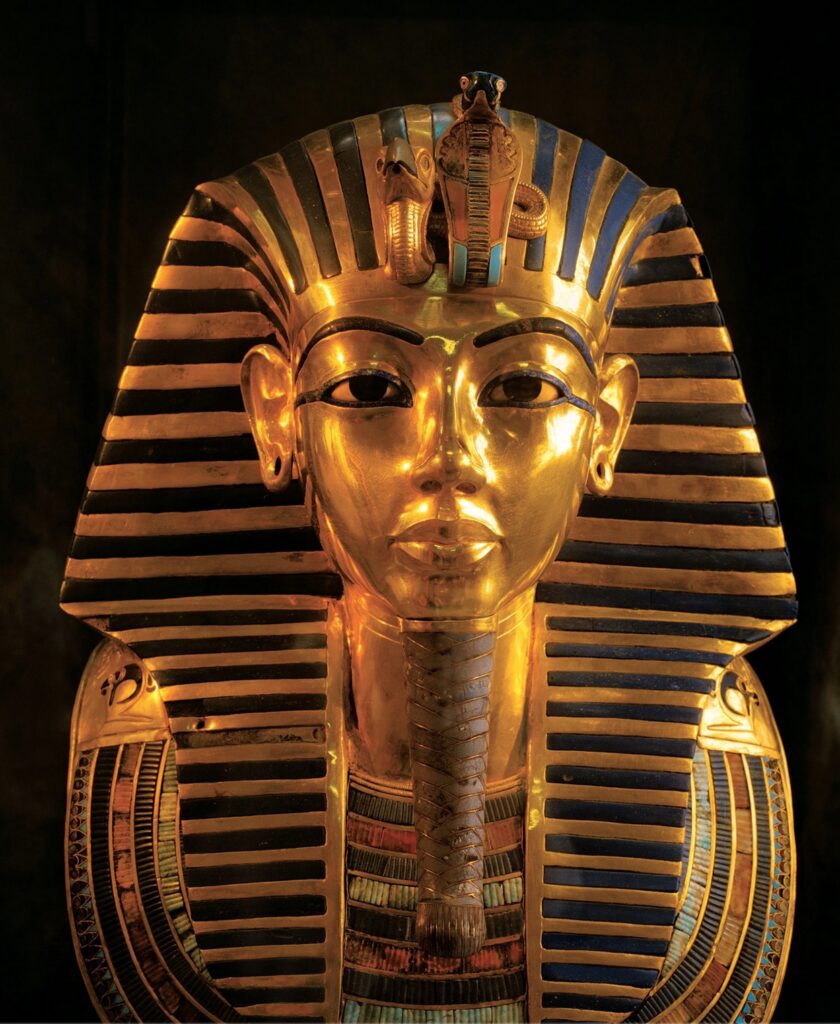
Many history websites and podcasts have done at least a few “specials” for the occasion, and I learned a whole bunch of stuff about good ol’ King Tut! From the reasons his tomb was miraculously spared from looters for more than 3000 years, to the sheer amount of stuff found in there (almost 5400 different items!), I realized I had only a microscopic understanding of this guy.
The Ancients podcast is running a number of episodes on the topic. This one with Professor Joyce Tyldesley gives a good overview of the “Boy King”. The second one has Bob Brier tell the story of Carter’s dig, and of who really found the tomb’s entrance, among other historical details.
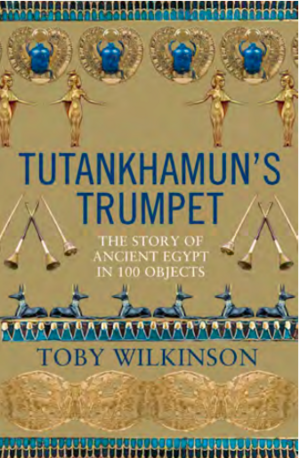
The excellent Tides of History podcast has an interview of Toby Wilkinson about Ancient Egypt and what we learned from the trove of items from Tut’s tomb. The Ancients podcast actually also had Toby Wilkinson in a previous episode, for the release of his new book on Tutankhamun which shines the light on the most interesting items from his tomb…
If you want to know what Tutankhamun’s trumpets looked like, look at this:
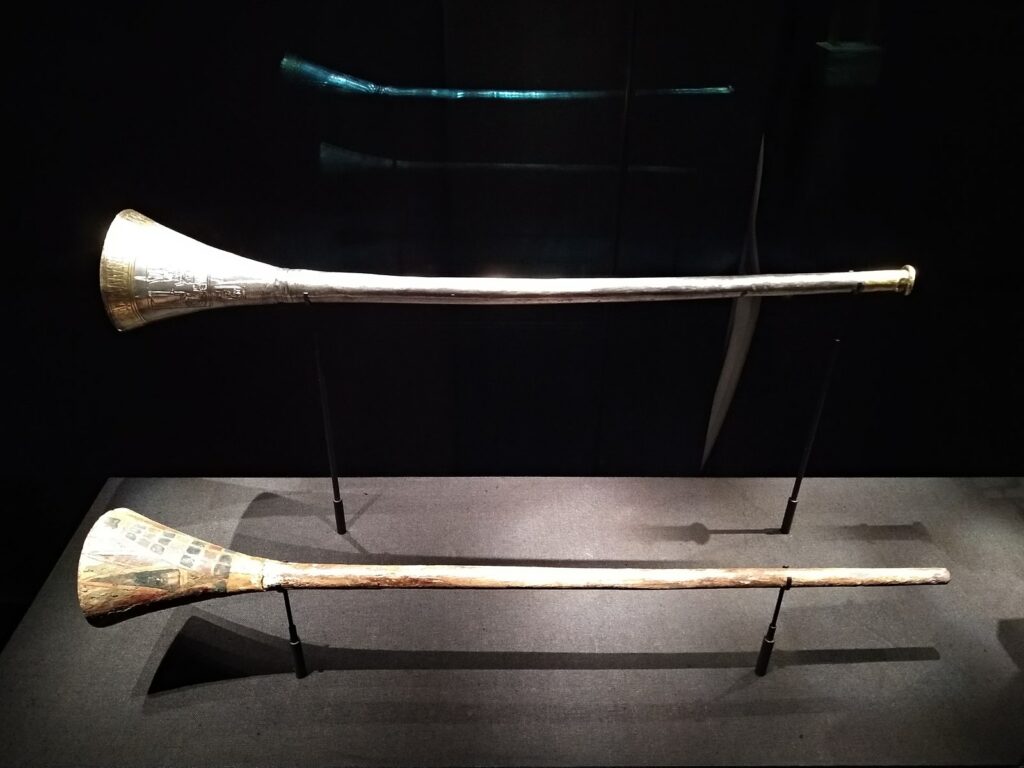
That’s a silver trumpet, by the way. The wooden thing below is the trumpet’s mute.
And maybe you even want to know what they sound like! Well, there’s this:
Of course, we have no idea what ancient Egyptians actually played on these trumpets…
Maybe you’ll be more interested in the Boy King’s board games, which looked something like this:
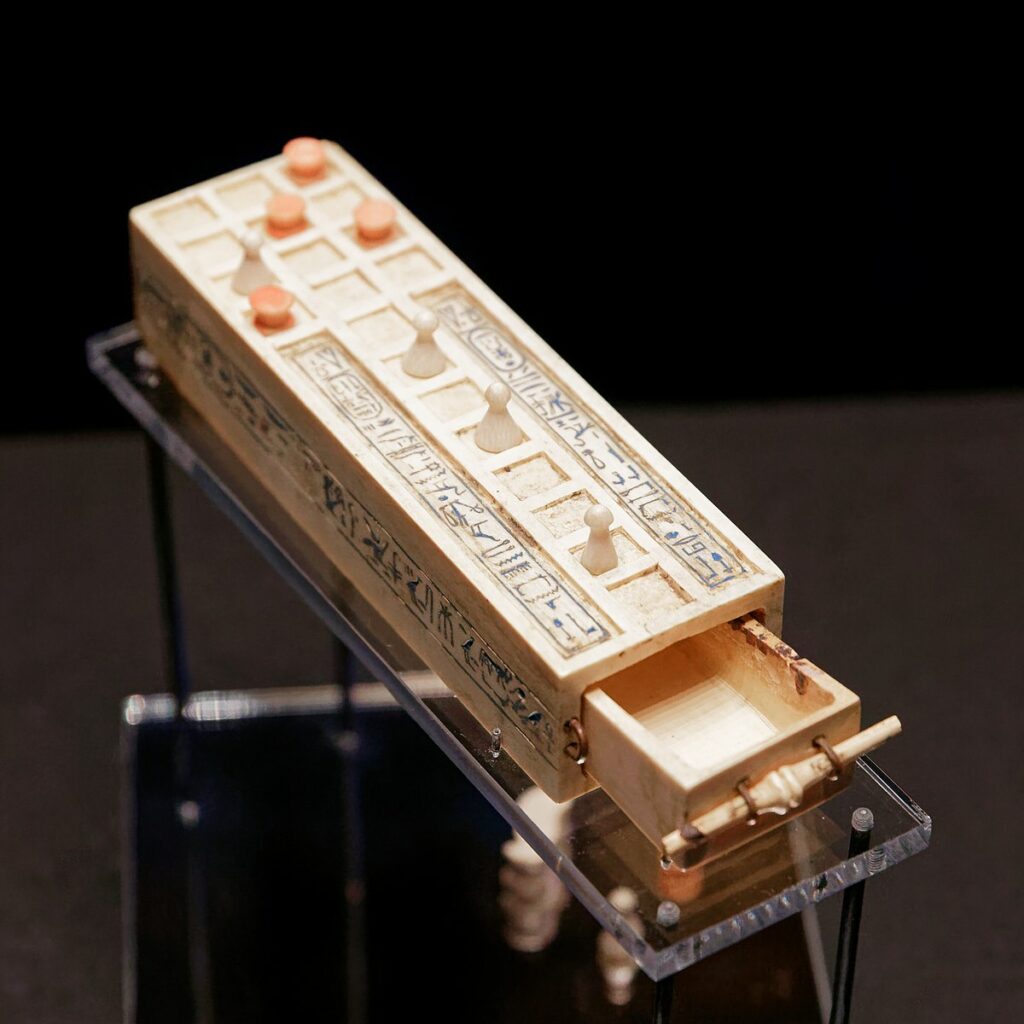
You can learn more about this sort of game here… anyway, happy tomb-raiding anniversary, King Tut!
Thank you for reading
That’s it for this week! Please contact us with any feedback, question, or news item we’ve missed!


